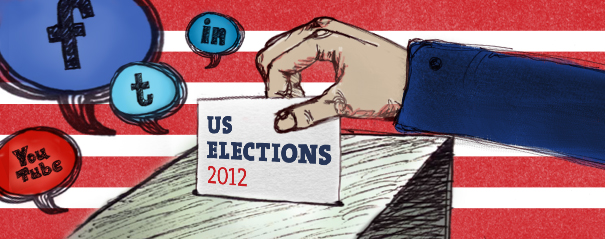
Since 2008, social media has expanded beyond the young user demographic and is continuing to enhance its personalization and interactivity. Which is why it turned the tables this presidential election, taking on a more proactive role by co-hosting debates, sponsoring town halls and creating new ways for voter/candidate communication. It’s awesome to see social media making a big impression that will forever change how future elections are ran. Thanks to their outreach, the 2012 elections are expected to be one of the highest voter turnout elections in U.S. history.
Just in case you missed it, here’s a quick recap of what social media has done for both candidates and tech-savvy constituents so far:
APRIL 20, 2011 – FACEBOOK TOWN HALL
Obama reconnected with the users responsible for his 2008 campaign success at Facebook’s headquarters. Moderated by Mark Zuckerberg himself, more than 1,700 questions to Obama were posted to the White House Facebook page and over 50,000 people watched the live-streamed event.
MAY 18, 2011 – YOUTUBE TOWN HALL
YouTube, owned by Google, created a channel for virtual debate. Users watch and decide which Congress members’ views they support before knowing which party the representative belongs to. The most supported videos are featured in the YouTube Town Hall Leaderboard. Congress members also respond to the top-voted user-submitted questions monthly.
JULY 6, 2011 – TWITTER TOWN HALL
Obama kicked off this event by making the first live presidential tweet in the White House. Twitter’s Executive Chairman, Jack Dorsey, then posed questions to Obama in real time that used the hashtag #AskObama. Radian6, Mass Relevance and curators monitored the tweets using Twitter’s search algorithms. Obama’s answers were condensed to 140 characters on @townhall and @whitehouse during the event.
SEPTEMBER 21, 2011 – TWITTER’S POLITICAL PAID ADVERTISING
Twitter allows candidates to purchase political Promoted Tweets, Trends and Accounts. Tweets feature a purple promoted icon and display a discloser line when hovered over. Unless you follow the accounts, the ads only appear on the top right corner of the UI, in trending topics and when you search for related topics.
SEPTEMBER 22, 2011 – GOOGLE/FOX NEWS DEBATE
Prior to the debate, about 20,000 viewers submitted more than 18,000 questions and 100,000 votes via text and video to the Fox News YouTube channel. As Google presented its public data and search trends in conjunction with debate questions, viewers voted on real-time polling questions and submitted comments as they watched. To top it off, the filing room was branded with Google’s logo and colors right down to the drinks.
SEPTEMBER 26, 2011 – LINKEDIN TOWN HALL
What better topic to discuss in a town hall hosted by the world’s largest professional network than job creation and the American economy. Similar to the Facebook Town Hall, CEO Jeff Weiner asked Obama questions from the live audience at LinkedIn headquarters as well as from more than 4,000 users in a specially created LinkedIn Group.
OCTOBER 6, 2011 – YOUTUBE POLITICS CHANNEL
Curated by Storyful, YouTube launched a channel that serves as the hub for all political videos by candidates, users, news networks, etc. You can also compare each of the major candidate’s YouTube stats including views, subscribers, video shares and amount of searches. While user-generated videos generate the most views, no one has been able to produce the same virality as the “Obama Girl” music videos.
JANUARY 8, 2012 (TENTATIVE) – NBC NEWS/FACEBOOK GOP DEBATE
Facebook is scheduled to co-host a primary debate on NBC’s “Meet the Press” moderated by David Gregory. There’s not much information about the interactive elements, only that this first-of-its-kind debate will be an innovative, multi-platform forum that will make history. Meanwhile, users can go to the Meet The Press and US Politics Facebook pages to share questions for the debate and interact with others.
Although we’d like to think the social media giants are facilitating these events entirely out of the goodness of their hearts, “their proactivity is backed as they hire lobbyists, form political action committees and nurture their relationships with lawmakers whose policy decisions affect the companies’ bottom line.” In other words, social media is using its power to “friend” politicians and reinforce its privacy issues, algorithms, advertising, censorship, etc.
Regardless of its corporate motives, this just means we’ll have an even better social experience and more marketing opportunities as it attempts to get government “approval” to develop its technologies further. We applaud social media for pushing its innovation (and politician friending) to bring the outdated practices of campaigning to the 21st century. By taking initiative to generate political conversation in the digital landscape, its shown its capabilities and proven itself a necessity for more than just elections.